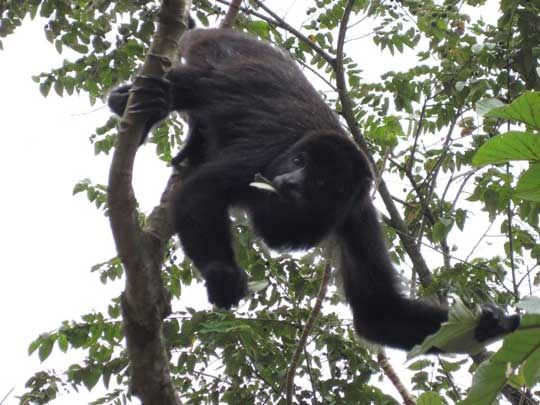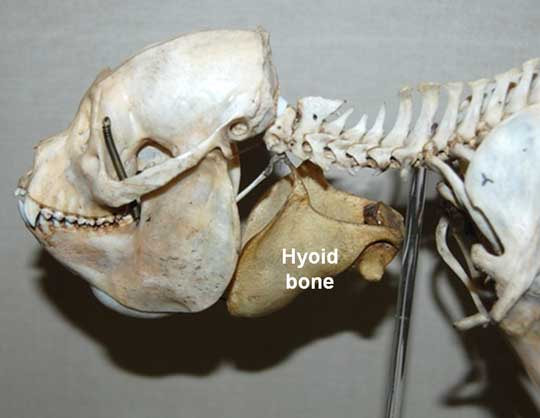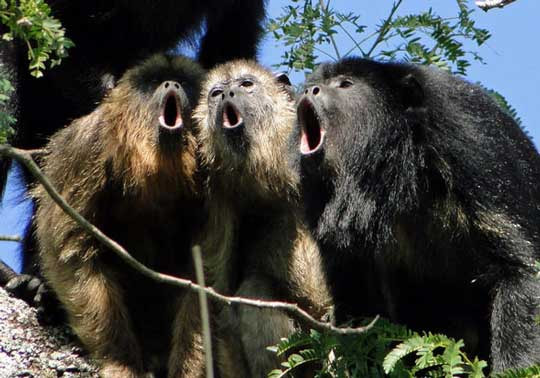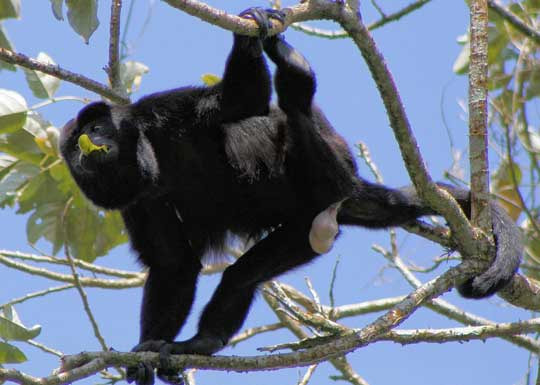|
We all remember our first time, right? I'm talking about the first time I ever saw a monkey in the wild... geez, what'd you think I was referring to? It was 2010. Trish and I saved up our hard-earned pennies, and we traveled to Belize. At a place called Lamanai, where there are some fascinating Mayan ruins, a black howler monkey came down in a tree within a few meters of us, allowing me to get a decent photo: That was on the first day, and then later that evening, we had our first opportunity to listen to the behavior that gave these monkeys their name. When howler monkeys feel threatened, and especially when one troop comes upon a second troop, they howl. I mean they really howl. Not only is it amazingly loud, it also sounds kind of haunting and ominous. I didn't get a recording of the black howlers in Belize, but a few years later Trish and I were canoeing in Costa Rica when two troops of mantled howler monkeys got into a dispute, howling at each other across the river from both sides of us. Here's a video I recorded of that dispute. Be sure to turn your speakers up to fully appreciate their howling. Amazingly, these calls can be heard up to three miles away! What the heck is a Howler Monkey? Howler monkeys are some of the largest monkeys that live in Central and South America. Howlers, of course, are monkeys, which means they are in the order Primates. There are fifteen species of howler monkeys, all of them in the family Atelidae. Howlers are the only New World monkeys that are folivores. This means they eat leaves. They also eat flowers, nuts, and fruits, but they mostly love eating the leaves at the top of the canopy. Needless to say, they must be fantastic climbers in order to do this. Amazing facts about Howler Monkeys I'm going to focus mainly on one thing—the howler's reputation for being extremely loud. Why do they have this reputation? Because they are extremely loud! They are actually in the Guinness Book Of World Records as the loudest land animal. This cacophonous call is possible because male howlers have extra-large throats. Also, they have a really cool hyoid bone. Usually, the hyoid is a horseshoe-shaped bone that helps with swallowing and tongue movement. But in howler monkeys, the bone has become a large resonating chamber in the throat. See the image below. You could certainly hear the mantled howlers in my video above, but the monkeys themselves weren't very visible. You really need to see one of these monkeys up close as it is calling, so... Check out this video of a Red Howler Monkey! Now, the next question is, why do howler monkeys call so loudly? Howler monkeys are highly territorial. They live in troops of six to fifteen monkeys, and they howl to broadcast their position to other troops, warning them to keep their distance. When one troop actually comes within sight of another, the resulting shouting match can be impressive. Wait! There's more to the story. Yes, howling is a way to defend their territory, but that's not all. This howling behavior is also very important for communication within a howler monkey troop. In fact, this is a primary way for the males to attract mates. In many animals, the males have certain physical features for impressing the females: a peacock's (and a turkey's) tail feathers, a deer's antlers, a drake mallard's bright green head, and many others. But in howler monkeys, volume is king. Louder males tend to get the females. So, it's not surprising that males have huge hyoids and females don't. Warning: If you are reading this to your young kids, you are now entering the territory of mating habits, sperm cells, and testicles. Now, let's explore this even further. Recent studies have shown that howler monkeys with larger hyoids (louder calls) have smaller testicles. Monkeys with smaller hyoids (quieter call) have larger testicles. Hmm... interesting. I should explain. Important Fact #1: We all know what testicles are for, right? Just in case you aren't sure, testicles produce sperm cells. Sperm cells are necessary for a male to impregnate a female, thus producing offspring. The larger the testicles, the more sperm cells the male can produce. For a male howler, producing more sperm cells is a good thing. Important Fact #2: For a male howler, it's also a good thing to have a larger hyoid. Why? Because a larger hyoid results in a louder, lower voice. Guess what kind of voice is most appealing to the females... yep, a louder, lower voice. Important Fact #3: Both of these features are expensive. By expensive, I mean they take a lot of energy to produce. So, it's a tradeoff—male howlers can have large hyoids, or they can have large testicles, but they can't have both. Bummer. The Amazing Result: Some species of howlers live in groups in which there is only one male and many females. In these species, the males try to attract as many females as possible (otherwise they'll end up living alone). How do they attract all these females? By having a loud, deep call (a large hyoid but small testicles). Other species live in groups in which there are numerous males instead of just one. In these species, it is helpful for the male to produce lots of sperm (large testicles but small hyoid). Why does it help for them to make lots of sperm? Because in these species the competition for mates comes aftercopulation. A greater volume of sperm gives these males a better chance of impregnating a female. Each female mates with all the males, and so all those sperm cells are racing to fertilize the egg. The more runners a male has in the race, the better chance he has of winning. Make sense? Below is a male howler monkey. As you can probably guess, this is a species with a relatively small hyoid bone. So, the Howler Monkey deserves a place in the S.A.H.O.F. (Sick Animal Hall of Fame). FUN FACT: The word sick originated before the year 900. It has always had the meaning, afflicted with ill health or disease. However, in the 1980s, the word became popular with surfers and skateboarders as a way to express "shock and awe" after seeing something amazing ("that stunt was sick"). Now it is used to praise just about anything (that episode of The Simpsons was sick!). So, sick is another way to say awesome! Photo Credits:
Black Howler in Belize - Stan C. Smith Howler skeleton with Hyoid - Evolutionary Literacy Three Howlers howling - Mariana Raño via Scientific American Black howler monkey with testicles - Scott Robinson vis Slate
0 Comments
Leave a Reply. |
Stan's Cogitations
Everyone needs a creative outlet. That's why I write. Archives
July 2024
|





 RSS Feed
RSS Feed